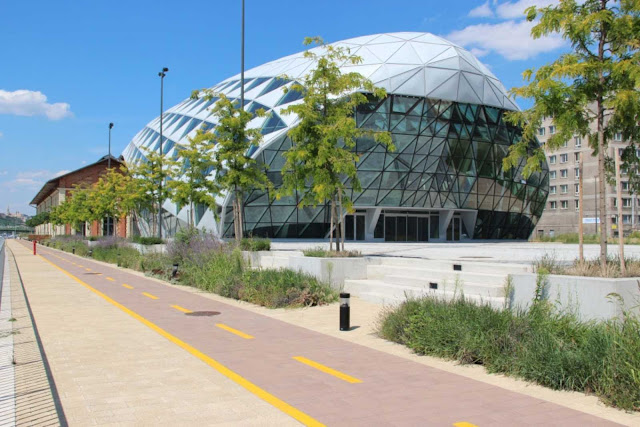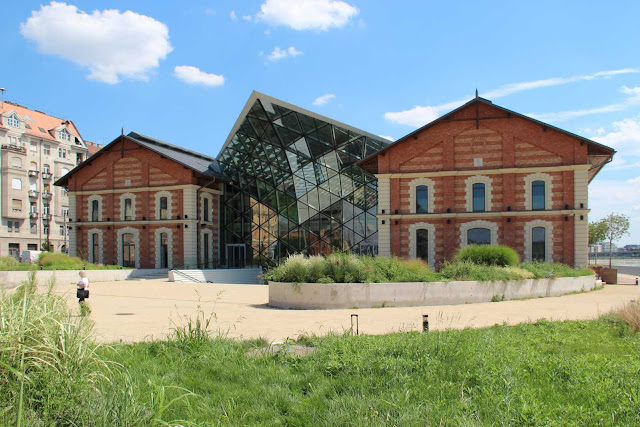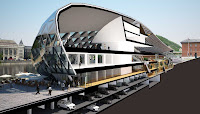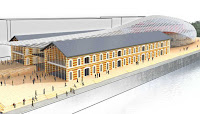The CET concept refers to Budapest as an important metropolitan centre in the heart of Central Europe. The CET shape refers to the smooth and friendly streamlined body of a whale.
The new CET development has the potential to put Budapest once again on the map of the world. Name and shape of the CET symbolizes its cultural potential and commercial pole position in one of the best preserved cities in the world.
Flow. The river Danube fascinates in Budapest for its fast flow on its trajectory downward from the Schwarzwald to the Black Sea. While the Danube both separates and unites Buda and Pest, the CET aims at re-establishing visual contact at this point between the two sides of the river.
Newly planned inviting terraces will visually open the once hermetic Közraktárak to the University and the Gellért Hotel. Hopefully a watertaxi system will be re-introduced to create direct connections for the people between the two sides as well. The body of the CET landmark building is developed along the flow of the Danube. Its architectural and urban expression evolves with the direction of the flow.
The CET’s origin stems from the side of the city centre, grows in size between the two parallel existing buildings of the Közraktárak and then culminates at the south side, the side of the National Theatre and the new Cultural Centre, in a striking landmark building representing the state-of-the-art in architectural design and building technology, its impact on the city will be not unlike the removed Elevator Building from the 19th Century from where the goods were distributed to the 6 warehouses which originally occupied the banks of the Danube.
Transformation from Old to New. Three of the 6 warehouses are now remaining, and the brief requests to keep at least 60% of the volume intact, while rightfully demanding to take away the first 20m of the 2 warehouses closest to the city to create a small square to improve the connection with the city south of the beautifully renovated Vásárcsarnok.
Taking this into consideration, the design team proposes to develop the Közraktárak landmark complex in a smooth transition from old to new. The first two warehouse buildings will be carefully renovated while adjusting the size of the vertical windows as to open up the hermetic nature of the buildings to the Danube, to the interior gallery and reach out to the adjoining district with the succesful Ráday utca nearby.
The building envelope consists of glass panels with aluminum frames, carefully positioned on a structural framework of steel tubes, to maximize the use of natural light and minimize overheating inside the atrium. The team made use of the program ONL BIM to design the glass atrium connecting the two historic spaces.
The project commissioned by the Port Authority of Budapest ONL Architects team was awarded the Autodesk BIM Experience Award for the use of new information technologies in the construction of the modeling process and its innovative character.
The CET building is a project that not only rejuvenates impressive historic buildings, but it uses the architecture and innovative technology to create a mixed-use living space and improve urban spaces for the public.
Location: Kozraktar, Budapest
Architect: ONL
Design supervision: Kas Oosterhuis, Ilona Lénárd,
Project architect: Marthijn Pool
Project manager: Bèla Káli
Project Team: Kas Oosterhuis, Ilona Lénárd, Gijs Joosen, Owen Slootweg, Bas Wijnbeld, Anna Nagy, Bujdosó Attila, Márku Judit, Romvári Péter, Tom Krzempek, Rafael Seemann, Paulina Gurak, Michael Gorczynski, Lidia Badarnah, Jan Gasparik, Petr Vokal.
Partners: MTM Statika - Lead structural engineering
MEP engineering: SMG-SiSu
Gross Floor Area: 18500 m2
Parking garage: 7500 m2
Year: 2011
Client: Porto Investment Hungary Kft., Budapest
Photographs: Courtesy of ONL, Romeodesign






















